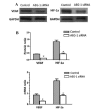Expression of astrocyte elevated gene-1 closely correlates with the angiogenesis of gastric cancer
- PMID: 24765154
- PMCID: PMC3997719
- DOI: 10.3892/ol.2014.1950
Expression of astrocyte elevated gene-1 closely correlates with the angiogenesis of gastric cancer
Abstract
Previous studies have demonstrated that astrocyte elevated gene-1 (AEG-1) is overexpressed in several cancer types and that its upregulation may promote cell proliferation, cell transformation and tumor progression. The present study investigated the expression and prognostic value of AEG-1 in primary gastric cancer (GC) as well as its role in angiogenesis. The results obtained from real-time reverse transcription polymerase chain reaction and western blotting revealed the upregulation of AEG-1 mRNA (P=0.007) and protein expression (P<0.001) in the majority of cancerous tissues compared with matched adjacent non-cancerous gastric tissues. To further investigate the clinicopathological and prognostic roles of AEG-1, immunohistochemical analysis of 216 GC tissue blocks was performed. The results showed that high AEG-1 expression closely correlated with differentiation degree (P<0.001 ), T stage (P<0.001), N stage (P=0.003) and M stage (P=0.013). Consistent with the abovementioned results, AEG-1 upregulation was also found to significantly correlate with poor survival in GC patients (P<0.001). Furthermore, carcinomas with elevated AEG-1 expression demonstrated high vascular endothelial growth factor (VEGF) expression and microvessel density, which was labeled by cluster of differentiation 34. In addition, an AEG-1 siRNA assay in MGC-803 cells showed that the AEG-1 gene may promote VEGF and hypoxia-inducible factor-1α protein and mRNA expression. The results of the current study indicated that AEG-1 may serve as a valuable prognostic marker for GC and may be involved in regulating tumor angiogenesis.
Keywords: angiogenesis; astrocyte elevated gene-1; gastric cancer; hypoxia-inducible factor-1α; vascular endothelial growth factor.
Figures







Similar articles
-
Overexpression of astrocyte-elevated gene-1 is associated with cervical carcinoma progression and angiogenesis.Oncol Rep. 2013 Sep;30(3):1414-22. doi: 10.3892/or.2013.2598. Epub 2013 Jul 8. Oncol Rep. 2013. PMID: 23835593
-
AEG-1 mRNA expression in non-small cell lung cancer is associated with increased tumor angiogenesis.Pathol Res Pract. 2017 Oct;213(10):1257-1263. doi: 10.1016/j.prp.2017.09.003. Epub 2017 Sep 7. Pathol Res Pract. 2017. PMID: 28941723
-
Expression characteristics of astrocyte elevated gene-1 (AEG-1) in tongue carcinoma and its correlation with poor prognosis.Cancer Epidemiol. 2013 Apr;37(2):179-85. doi: 10.1016/j.canep.2012.10.007. Epub 2012 Nov 9. Cancer Epidemiol. 2013. PMID: 23142337
-
Expression of astrocyte elevated gene-1: a novel marker of the pathogenesis, progression, and poor prognosis for endometrial cancer.Int J Gynecol Cancer. 2010 Oct;20(7):1188-96. doi: 10.1111/igc.0b013e3181ef8e21. Int J Gynecol Cancer. 2010. PMID: 21495225
-
Multifunctional Role of Astrocyte Elevated Gene-1 (AEG-1) in Cancer: Focus on Drug Resistance.Cancers (Basel). 2021 Apr 9;13(8):1792. doi: 10.3390/cancers13081792. Cancers (Basel). 2021. PMID: 33918653 Free PMC article. Review.
Cited by
-
Astrocyte Elevated Gene-1 as a Novel Clinicopathological and Prognostic Biomarker for Gastrointestinal Cancers: A Meta-Analysis with 2999 Patients.PLoS One. 2015 Dec 28;10(12):e0145659. doi: 10.1371/journal.pone.0145659. eCollection 2015. PLoS One. 2015. PMID: 26710214 Free PMC article.
-
Post-trimodality expression levels of metadherin (MTDH) as a prognostic biomarker for esophageal adenocarcinoma patients.Med Oncol. 2017 Aug;34(8):135. doi: 10.1007/s12032-017-0994-2. Epub 2017 Jul 6. Med Oncol. 2017. PMID: 28685276
-
The expression of AEG-1 and Cyclin D1 in human bladder urothelial carcinoma and their clinicopathological significance.Int J Clin Exp Med. 2015 Nov 15;8(11):21222-8. eCollection 2015. Int J Clin Exp Med. 2015. PMID: 26885058 Free PMC article.
-
AEG-1 induces gastric cancer metastasis by upregulation of eIF4E expression.J Cell Mol Med. 2017 Dec;21(12):3481-3493. doi: 10.1111/jcmm.13258. Epub 2017 Jun 29. J Cell Mol Med. 2017. PMID: 28661037 Free PMC article.
-
MicroRNA-542-3p suppresses cell growth of gastric cancer cells via targeting oncogene astrocyte-elevated gene-1.Med Oncol. 2015 Jan;32(1):361. doi: 10.1007/s12032-014-0361-5. Epub 2014 Nov 29. Med Oncol. 2015. PMID: 25432696
References
-
- Chen WQ. Estimation of cancer incidence and mortality in China in 2004–2005. Zhonghua Zhong Liu Za Zhi. 2009;31:664–668. (In Chinese) - PubMed
-
- Dudeja V, Habermann EB, Zhong W, et al. Guideline recommended gastric cancer care in the elderly: insights into the applicability of cancer trials to real world. Ann Surg Oncol. 2011;18:26–33. - PubMed
-
- Chen CN, Lin JJ, Chen JJ, et al. Gene expression profile predicts patient survival of gastric cancer after surgical resection. J Clin Oncol. 2005;23:7286–7295. - PubMed
-
- Kang DC, Su ZZ, Sarkar D, et al. Cloning and characterization of HIV-1-inducible astrocyte elevated gene-1, AEG-1. Gene. 2005;353:8–15. - PubMed
LinkOut - more resources
Full Text Sources
Other Literature Sources
Miscellaneous
